We in India love our Gods. We worship them, get angry at them, play with them, dress them, and even cover them with sweaters, shawls, mufflers, and mittens during winter. The beautiful interplay between Gods and humans is deeply entrenched in the Vaishnav philosophy. You can see a vibrant manifestation of this practice in Vrindavan, the divine play-zone of Sri Krishna.

Most doctrines of Hinduism consider gods to be a subterfuge to reach the core philosophies. However, as per the Vaishnav concept, Krishna is the ultimate god and Radha is his divine power. Krishna and Radha complete each other and are inseparable. Hence, in many temples of Vrindavan, there is a prominent Krishna idol with an obscure representation of Radha by way of a crown or an ornament or clothing on the side. It is as if Radha is present in spirit.
Unlike what we see in Delhi or other parts of India, this is love at another level in Vrindavan.
How to reach Vrindavan from Delhi NCR
We have always driven to Vrindavan but this time we wanted to take it easy. We booked ourselves in a bus that picked us at 7 am from IFFCO Chowk, Gurgaon, and dropped us by 11 am at Chhatikara on the Vrindavan highway.
The highway had many tolls and the major part of the highway in Haryana was in excellent condition with great view. There was a visible drop in road conditions and the surroundings when we entered UP. However, it was still ok and manageable.
From Chhatikara, we booked an autorickshaw that dropped us at the Vrindavan parking lot. The road was blocked for them after this point and our adventure began. On the way back, we boarded our bus from Mathura and was dropped in Gurgaon in about 4 hours.
Pin it for later Read

Day 01 – Vrindavan
The best season to visit Vrindavan is winter. It was pleasantly cold and we were full of energy when we reached.
The initial idea was to drop our luggage at our hotel and then start on our exploration. However, vehicles except cycle and electronic rickshaws were not allowed beyond the parking area. Consequently, we could not find any transport till our destination. We saw every other e-rickshaw was excited to go to the Banke Vihari Temple, perhaps the most famous shrine in Vrindavan. We took that as a sign and boarded an e-rickshaw saying, Jai Banke Bihari.
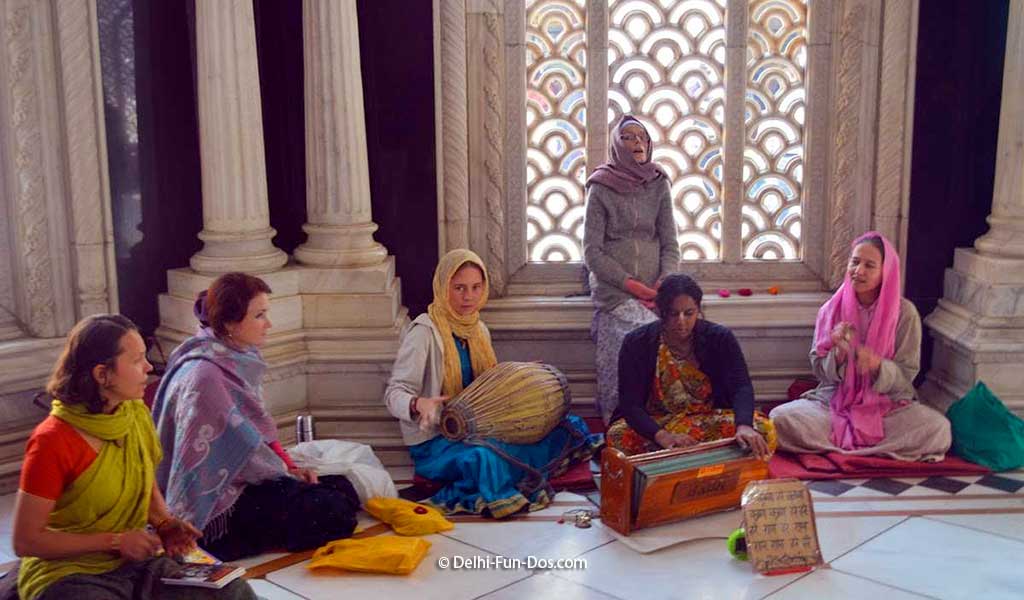
Banke Bihari Temple
Our e-rickshaw dropped us near a shoe-removal booth where we also stored our luggage at minimal charge. From there we started walking and walking through narrow winding roads popular as “Kunj Galiyaan of Vrindavan”. Thousands of pilgrims were on this route and most of them barefoot. The lanes were lined with shops selling religious statues and figurines, ingredients of worship, and food that was all vegetarian and devoid of onion and garlic as well.
In about half an hour the crowd started increasing and our pace became slower. We could see the high temple gate and we waited behind a big queue near the temple gate. There were monkeys all around eyeing spectacles and food packets. If they spotted a spectacle or a sunglass, they would snatch it and return it only in exchange of a pack of juice or a bunch of bananas. Smart we thought!
Meanwhile, the crowd starting moving and there was some pushing and shoving. Maneuvering through the crowd, we somehow managed to enter the temple and had a glance at the altar from the corridor. The Krishna statue here was a combined form of Krishna and Radha. We were told that the statue was originally worshipped in Nidhivan where after this temple was constructed and the statue was installed here in the year 1864. It is being worshipped in this temple thereafter.
We walked our way back through the designated exit and reached the shoe stand in another 25 minutes or so. Banke Bihari is the most important shrine in Vrindavan, and we have to admit, the darshan was a struggle. The discomfort of the hapless infirm devotees trying to handle the crowd and the queue was heart-wrenching. Once out of the shrine, we sighed in relief that we had ticked off Temple Banke Bihari.
ISKCON Temple, Vrindavan – Sri Sri Krishna Balaram Mandir

The ISKCON Temple in Vrindavan is located in the relatively new area. Given the road closures, it took us changing a couple of e-rickshaws and intermittent walks to reach the temple. But once we reached, we felt it was worth the effort.

The beautiful concrete marble structure in North Indian style had an open courtyard from where we could see all the main shrines. The central shrine had grand statues of the divine brothers Krishna Balaram, the right shrine was for Mahaprabhu Chaitanya and the left shrine carried idols of Radha Krishna and their mates or Sakhis Lalita and Vishakha. The idols were big and prominent and decked in bright clothes and flowers. Live chanting and kirtan by ISCKON inmates and devotees reverberated in the air. We also loved the chequered floor in the main courtyard.
Behind the shrine, they have living quarters as well as the Govinda restaurant that was open to all. We had ragi dosa there and that was new.
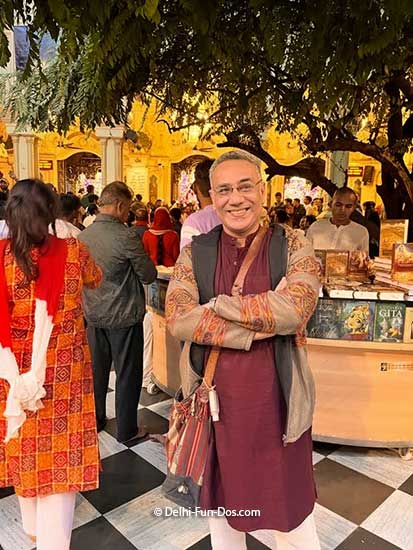
Sri Sri Krishna Balaram Temple reflects a simple form of Bhakti or devotion. If you are in Vrindavan, you must visit the ISKCON Temple for its joyous vibe.
Radha Ballabh Temple, Vrindavan
On way from Banke Bihari Temple, you would find a set of stairs with a variety of footwear at the bottom. This is one of the paths to the Radha Ballabh Temple, a 16th-century Krishna shrine in Vrindavan. But you do not have to leave your shoes here since once you climb up, you would find many landings with dedicated shoe stands near the main entrance to the temple.
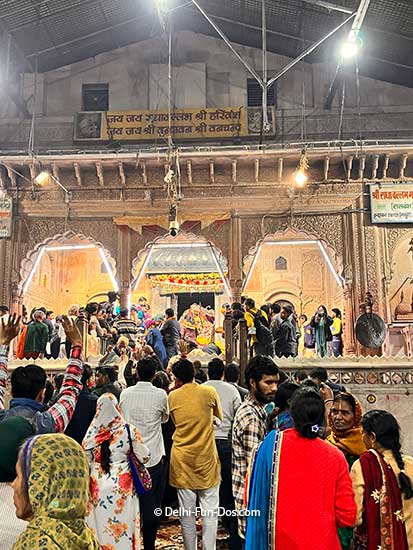
The temple is a magnificent red sandstone structure in North Indian style. The inside is a cosy courtyard with the sanctum sanctorum of Radha Ballabh at one end. Ballabh means beloved and the statue of Radha’s beloved Krishna is placed below an ornate canopy. The statue stands typically inclined towards the left. The divine face is decorated with ornate sandal paste designs. On the left of the Krishna statue is a crown that represents Radha.
Adjacent to the main shrine is a smaller shrine dedicated to Harivansh Mahaprabhu who is said to have established this temple under the divine calling of Goddess Radha. The story is goosebumps.
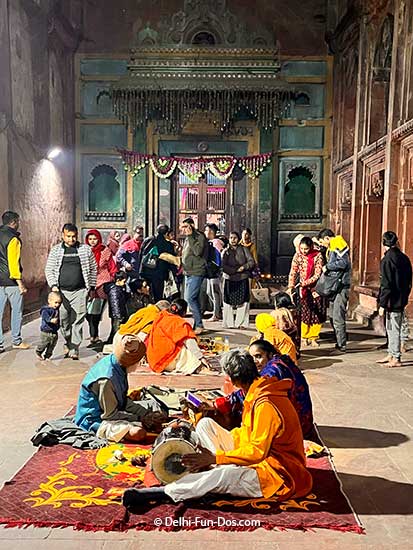
The ambiance of the temple invokes devotion and we could see many emotional devotees silently chanting their verses or looking at the Krishna idol in sheer trance. Believer or not, such sights are moving.
Radha Raman Temple, Vrindavan
Radha Raman refers to the one who entertains Radha, that is Lord Krishna. The Radha Raman Temple is another ancient temple that follows Sri Chaitanya style of Vaishnavism. This red sandstone temple was established 500 years ago by Gopal Bhatt Goswami, a direct disciple of Sri Chaitanya, and is still worshipped by his descendants.
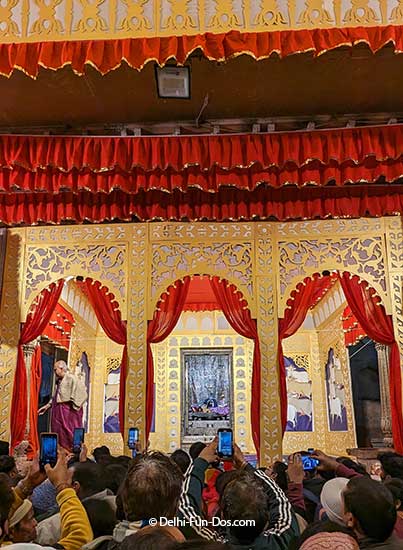
The Krishna statue here is a little smaller than the one at Radha Ballabh Temple. But it is equally graceful and has a small representation of Radha on the left. The temple was celebrating Premotsav when we went. The courtyard was decorated with beautiful artwork in a modern fusion style. They were holding live kirtan renditions inside the courtyard and that set the mood. We sat there for a while listening to the melodious songs as well as soaking in the joyous mood.
The Radha Raman temple has numerous legends associated with it and one of these is that the statue of Krishna manifested itself here. Scriptures or fairytales, the narratives were enchanting and the experience was regaled us.
Day 02 – Vrindavan and Mathura
Ranganathji Temple, Vrindavan
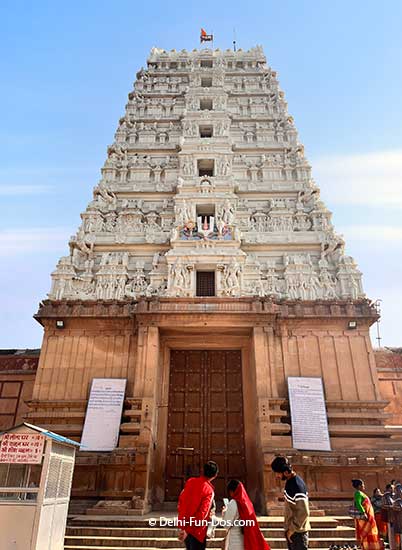
Built-in the Dravidian style of South India, the Ranganath or the Rangji Temple in Vrindavan was a grand affair. The high Gopurams were visible from afar. We were told this temple would take time so we kept this for the following morning.
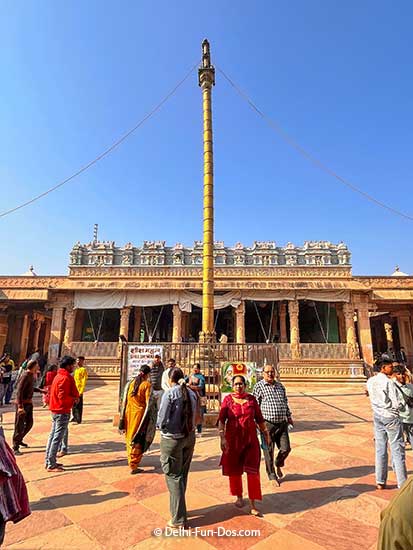
And we are glad that we waited. There was a lot to see here. Built-in the year 1845 or so, the carved pillars and the ornate paintings on the walls were of museum quality. There were many shrines in the sprawling complex. The main shrine was dedicated to Lord Vishnu in the sleeping posture – Anantashajya along with his consort Goddess Lakshmi. There were other shrines dedicated to Ram-Sita, Shiva, and Narasimha. A gold-covered mast or the Dhwaja (flagpole) in the main courtyard was shining bright in the winter sun. While we clicked and clicked in this temple, this spot was the most popular photo point.
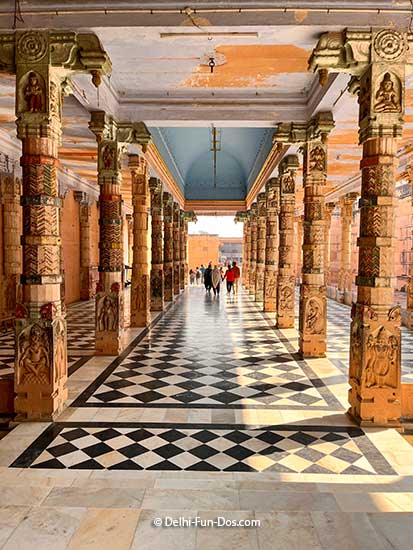
It took us over an hour to explore this temple. We are glad that we devoted this time. Rangji Temple was different from all the other temples of Vrindavan and the ornamentation was a huge portrayal of Indian fine arts.
Nidhi Van
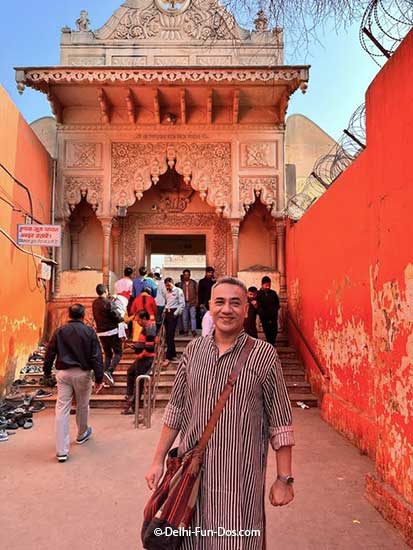
Vrindavan is a portmanteau of two Sanskrit words – Vrinda which means the holy basil – Tulasi and Van or forest. The Tulsi forest of Vrindavan is now maintained in Nidhi Van – a garden with hundreds of Tulsi trees.
A walkway among the Tulsi trees take you through the many shrines and a dressing room for Radha and Sri Krishna. The Krishna idol in the Banke Bihari shrine used to be worshipped here till the mid-nineteenth century whereafter it was moved.
Nidhi Van is perhaps the spot with the most fascinating legends. It is believed that the Tulsi trees here are the Sakhis or the divine companions of Shri Krishna and Radha. These trees turn to life every night and Shri Krishna comes and performs the divine Raas
Leela with each and every one of them. In fact, the houses surrounding the Nidhi Van do not have any window overlooking this area since any glance into this forest post-sundown can prove ominous. The story is goosebumps.
Our Vrindavan tour was coming to an end. After a quick brunch, we checked out of our lodging and took a bus to Mathura.
Krishna Janmabhumi Temple, Mathura
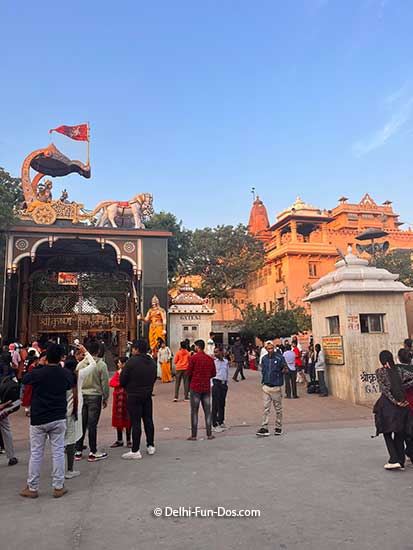
It is well-known that Sri Krishna was born to his father Vasudev and mother Devaki in a prison in Mathura. The Krishna Janmabhumi shrine is representative of that prison and there is a small cosy temple inside the recreated labour room. There is a small Durga shrine here. There is a gorgeous Radha Krishna shrine in the complex. Reaching the Radha Krishna Temple involves some climb but also provides a nice view of the surroundings. There is also a museum that represents the story of Shri Krishna and Govardhan Mountain.
Excavations at this site have revealed evidence of various temples here since over 2000 years. Sadly, the ancient temples were destroyed by various invaders and Aurangazeb built a mosque, the Shahi Eidgah on the plot. After many court cases, a major part of the land was acquired and the present temple complex was built after 1951 by contribution of patrons. However, the mosque is still the subject matter of many court cases.
Last but not least, there are many lassi and peda shops in the surrounding areas as well as inside the temple complex. We tried some items and it was all very tasty. Beware, you have to deposit all your belongings except your wallet at the cloakrooms before entering the temple. Photography is prohibited here.
What else you can do in Vrindavan
Yamuna Arti
You can visit the banks of River Yamuna in Vrindavan and go for a boat ride too. In fact, there is a Yamuna Arti ceremony held every evening at sunset where priests chant mantras and wave lamps saluting the river. You can attend that if you have time.
Shopping for votive items
You would get all possible votive items here. In fact, this region is known for cute costumes and sequined ornaments for idols. So, if you want to add oomph to your altar, this is the place.
Where to stay in Vrindavan
There are numerous hotels, homestays, and ashrams where you can stay in Vrindavan. These spots cater to all kinds of budget and requirement. We stayed at a simple homestay near Nidhivan that we had booked online.
Given that Vrindavan is a popular tourist destination, there are chances that you would be misled. While most of us book accommodation online, ask questions and satisfy yourself that the place is safe and meets your needs.
What to eat in Vrindavan
Vegetarian meals
Simple North Indian meals are available in eateries sprinkled all over the city. You get a simple daal–rice–roti–sabzi lunch and dinner. Parathas, fritters, jalebis, and chai are also available.
Pedas from Vrindavan
Pedas are sweets that are made by drying milk, adding sugar and flavours such as cardamom. They come in some varieties depending on their softness. While you find pedas in almost all of North India, pedas from Vrindavan are famous. We bought pedas from Kundan sweet shop and everyone loved it.
Lassi in Vrindavan
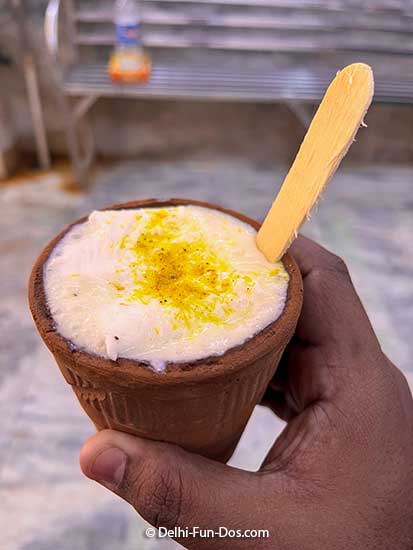
Sri Krishna, as we all might know, is the most famous cowherd ever. This region is traditionally well-known for dairy. The thick milk here makes tasty filling lassies. These lassies would earlier be mixed by hand. This process has now been mechanized. Yet the lassies are delicious so you would be sorry to not have tried some.
There is so much more to do in Vrindavan. Some many more temples and museums. But that is for a longer trip. This was a one and half-day’s itinerary in Vrindavan. A mix of fun, food, and divinity, we would love to do it all over again.
Also read – https://delhi-fun-dos.com/visiting-ancient-indian-cities-mathura-vrindavan/


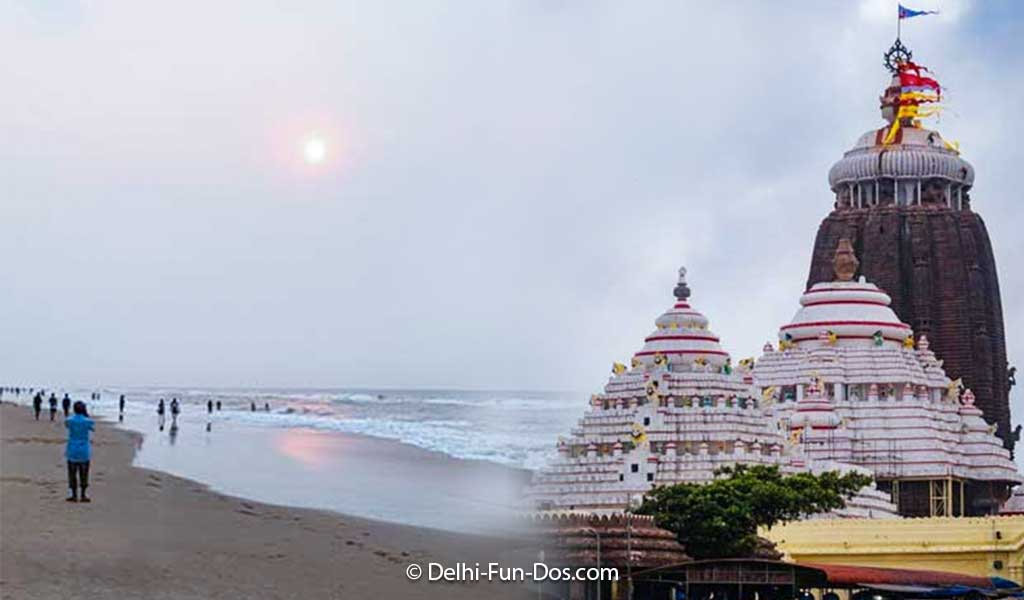
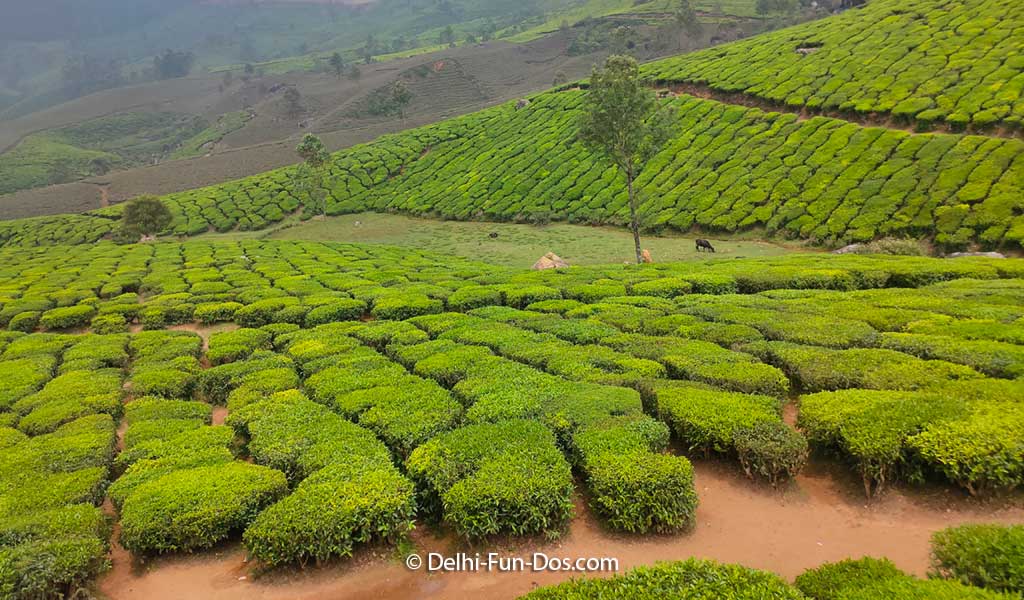
This is absolutely amazing. I’ve only been to Vrindavan once, and that was when I was a child. I really appreciate your itinerary, it looks like a perfect blend of enjoyment, delicious food, and spiritual experiences.
Time for another visit…
Vrindavan is seriously a different vibe. The ranganath temple tower looks mesmerizing. I absolutely love the mention of food available. Will plan to visit
You should not miss choley tikki and golgappe, just outside shri baanke bihari temple. It gives me lot of peace at Vrindavan.
We tried the golgappe but thought Delhi was better 😀
Thank you for this insightful guide to Vrindavan’s temples! Your descriptions provide a wonderful glimpse into the spiritual richness of the area. I appreciate the effort you’ve put into sharing these details, making it easier for others to embark on their own spiritual journey in this sacred place.
Most welcome
I have lived in Mathura in the early 9 years of my life, so I am deeply attached to these holy places. Can’t even count the number of times I have visited all these temples with my relatives. Well one thing is to be kept in mind are the monkeys. They are a real nuisance and can totally sabotage the trip!
so well summarised